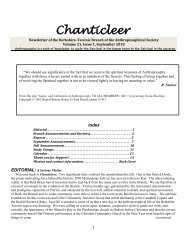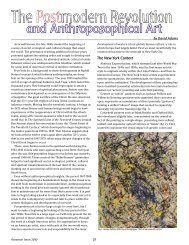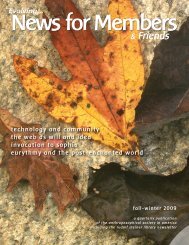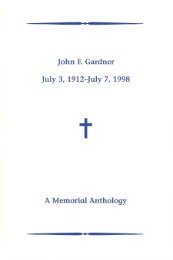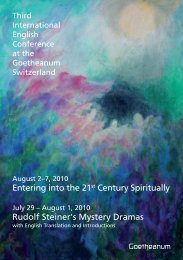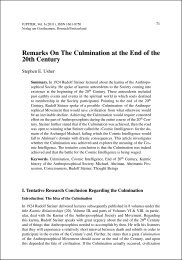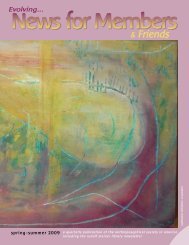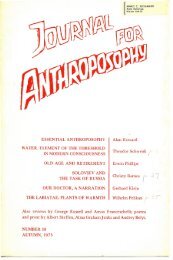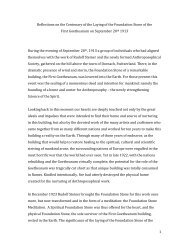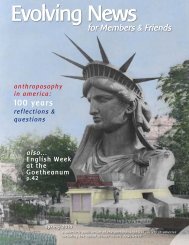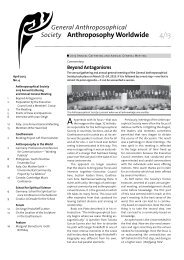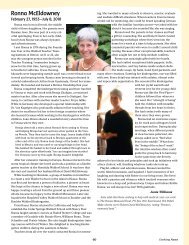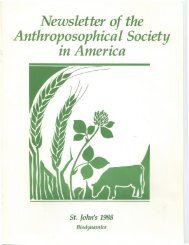Rudolf Steiner's Vision for the Future - Anthroposophical Society in ...
Rudolf Steiner's Vision for the Future - Anthroposophical Society in ...
Rudolf Steiner's Vision for the Future - Anthroposophical Society in ...
Create successful ePaper yourself
Turn your PDF publications into a flip-book with our unique Google optimized e-Paper software.
The Radical Re-<strong>Vision</strong><strong>in</strong>g of Psychology<br />
Movement II<br />
James Dyson spoke of one of <strong>the</strong> card<strong>in</strong>al dilemmas<br />
of <strong>the</strong> soul: its separation from substance and <strong>the</strong> long<strong>in</strong>g<br />
<strong>for</strong> re-unification with substance. This journey of separation<br />
was explored from an esoteric evolutionary po<strong>in</strong>t of<br />
view. Dyson was able to characterize this movement of <strong>the</strong><br />
soul as desire and its long<strong>in</strong>g <strong>for</strong> reunification with<br />
substance as part of <strong>the</strong> dynamic of human relationships.<br />
Through his explication <strong>the</strong> world of desire became more<br />
than a polarity of sympathies and antipathies, more than<br />
<strong>the</strong> psychoanalytic notion of sexuality as <strong>the</strong> basis of<br />
human maturation. Instead it became filled with an<br />
ontological drive <strong>for</strong> wholeness, <strong>for</strong> a sense of completion<br />
that souls seek through relationships with one ano<strong>the</strong>r.<br />
Movement III<br />
In William Bento’s talk <strong>the</strong> soul’s relationship with<br />
time was highlighted. He described observations of how<br />
<strong>the</strong> soul is undergo<strong>in</strong>g a high level of stress due to an actual<br />
acceleration of time. Of particular note were his remarks<br />
about <strong>the</strong> stream of time com<strong>in</strong>g from <strong>the</strong> future as be<strong>in</strong>g<br />
<strong>in</strong>tensified with images of <strong>the</strong> Apocalypse, and his shar<strong>in</strong>g<br />
<strong>the</strong> occult fact reported by Ste<strong>in</strong>er that <strong>the</strong> e<strong>the</strong>ric (protective)<br />
sheath of <strong>the</strong> heart would cont<strong>in</strong>ue to loosen <strong>in</strong> this<br />
century. Bento <strong>in</strong>ferred that <strong>the</strong>se two phenomena have<br />
created a cultural pathology of Pre-Traumatic Stress<br />
Syndrome. His diagnostic and <strong>in</strong>terventional <strong>for</strong>mulation<br />
of and <strong>for</strong> this pathology was presented <strong>in</strong> <strong>the</strong> follow<strong>in</strong>g<br />
chart:<br />
30 • be<strong>in</strong>g human<br />
Bento concluded by stat<strong>in</strong>g a press<strong>in</strong>g need to trans<strong>for</strong>m<br />
<strong>the</strong> context of psycho<strong>the</strong>rapy from one of encounter<br />
to one of accompaniment — accompaniment as friends<br />
on a universal human path of <strong>in</strong>itiation. In this assertion<br />
Bento struck a note of <strong>the</strong> radical re-envision<strong>in</strong>g of<br />
psychology that seemed to pervade and persist throughout<br />
<strong>the</strong> conference.<br />
Movement IV<br />
From an entirely different orientation than William<br />
Bento, Dennis Klocek was also able to po<strong>in</strong>t out ano<strong>the</strong>r<br />
alarm<strong>in</strong>g pathology of our time. Dennis explored a<br />
neuropsychological map of <strong>the</strong> bra<strong>in</strong> that cast light upon<br />
<strong>the</strong> rapidly <strong>in</strong>creas<strong>in</strong>g autistic spectrum. If one did not<br />
have a certa<strong>in</strong> respect or reverence <strong>for</strong> science prior to<br />
listen<strong>in</strong>g to Dennis’s cogent and <strong>in</strong>cisive illustrations of<br />
how <strong>the</strong> soul is at play <strong>in</strong> utiliz<strong>in</strong>g <strong>the</strong> <strong>in</strong>strument of <strong>the</strong><br />
bra<strong>in</strong>, one would surely have been given reason to do so.<br />
Dennis expla<strong>in</strong>ed that <strong>in</strong> <strong>the</strong> autistic spectrum issues of<br />
sensory <strong>in</strong>tegration, spatial perspective, and contextual<br />
mean<strong>in</strong>g (key factors <strong>in</strong> <strong>the</strong> limbic region of <strong>the</strong> bra<strong>in</strong>)<br />
become fragmented, impaired and dysfunctional agents of<br />
process<strong>in</strong>g stimuli. Due to an underly<strong>in</strong>g lack of neural<br />
stability and agility this phenomena tends to lock one <strong>in</strong>to<br />
a set pattern of idiosyncratic behaviors. Yet Dennis also<br />
reported recent research that states one can stimulate and<br />
grow more neurons, <strong>the</strong>reby giv<strong>in</strong>g hope to <strong>the</strong> autistic<br />
person, whom so many have accepted as souls entrapped<br />
by deficient neurological apparatus.<br />
Movement V<br />
Dr. Dyson returned to his <strong>the</strong>me concern<strong>in</strong>g <strong>the</strong> soul<br />
and substance. Referr<strong>in</strong>g to Dennis’s neurological map of<br />
<strong>the</strong> bra<strong>in</strong> James cited <strong>the</strong> <strong>in</strong>terplay <strong>in</strong> <strong>the</strong> two hemispheres<br />
of <strong>the</strong> bra<strong>in</strong> as possibly depict<strong>in</strong>g how <strong>the</strong> soul lives <strong>in</strong><br />
space and time. This time he probed <strong>the</strong> mystery of <strong>the</strong><br />
will and its role <strong>in</strong> psychological development. Some of<br />
this content was fur<strong>the</strong>r developed <strong>in</strong> his workshop on <strong>the</strong><br />
seven life processes, as it can be understood <strong>in</strong> <strong>the</strong> doma<strong>in</strong><br />
of <strong>the</strong> soul. His <strong>the</strong>sis led us through <strong>the</strong> esoteric physiology<br />
of body and soul <strong>in</strong>to Wil<strong>for</strong>d Bion’s radical psychoanalytic<br />
ideas about <strong>the</strong> foundation <strong>for</strong> mental



